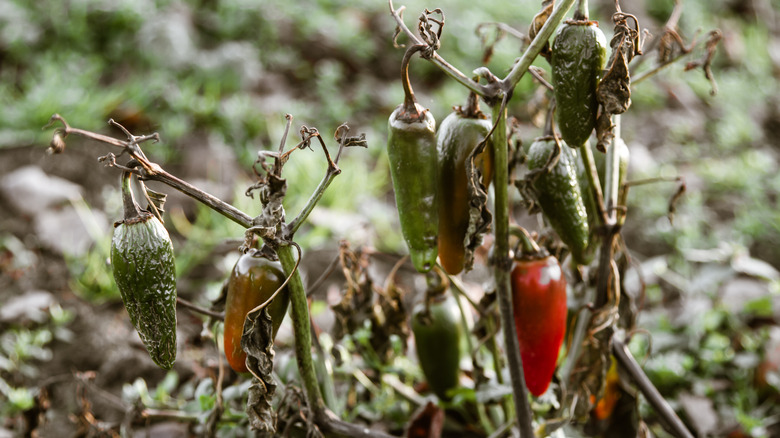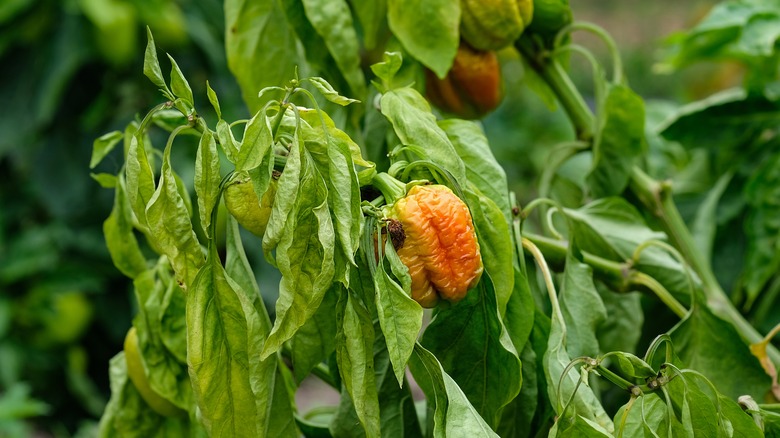Common Reasons Your Pepper Plant Is Wilting & What You Can Do About It
You've achieved garden magic and turned your store-bought produce into a flourishing pepper plant. But just before you get to sample the efforts of your labor, you encounter the dreaded droop. Don't give up on it just yet. The plant might be salvageable, but you'll have to spend a little time troubleshooting what's causing the leaves and stems to lose their vigor.
Most commonly, pepper plants wilt because they either have too much or too little water. Bacterial, fungal, or viral diseases that cause plants to slump can't be remedied, but you can prevent them with good gardening practices. Insects like aphids and nematodes could also be to blame for withering stems. Battle them with hand-plucking, soapy water, solarization, or, as a last resort, insecticide.
To properly diagnose the problem, you first need to know what a healthy pepper plant — Capsicum annuum and its varieties and cultivars — looks like. Pepper plants in their prime stand to attention on sturdy, semi-woody stems with bushy, bright green leaf growth. Leaves should be free from spots or blemishes. At maturity, they can grow to 4 feet in height. They should have lots of flowers that stay on the plant (significant flower drop is also a sign of pepper plant problems), and the fruit should be big, shiny, and colorful — healthy hues include bright reds, oranges, yellows, browns, greens, and purples.
Understanding the many root causes of pepper plant wilt
Over or under-watering is probably the most common droop culprit. A pepper that's thirsty and hot in midday summer sun or drowning in endless rain will flop fast. If the pepper seedlings you recently moved from your greenhouse or the nursery to your garden beds are wilting, they probably have transplant shock. It's also worth noting that they won't survive if they're planted near a black walnut tree. Black walnut trees have juglone, which can cause walnut toxicity in nearby plants, including peppers. They'll look limp before they keel over.
Disease might also be responsible for your pepper plant's inability to stand up straight. Pepper bacterial wilt (Ralstonia solanacearum) infects leaves, fruit, and especially the stems. They lose their vibrant green and appear watery or hollow. The symptoms of fungal fusarium and verticillium wilt are strikingly similar: leaves turn yellow, and the plant wilts during the day. Root and crown rot, caused by the fungus Phytophthora capsici, infects pepper roots and stems, causing plants to dry, turn brown, and droop. Despite its name, tomato spotted wilt virus is a cause of wilt in pepper plants, too. It's spread by tiny, sap-slurping insects called thrips.
Thrips aren't the only destructive pests that'll eat your peppers before you can: Aphids can cause a plant to wilt as they drain its lifeblood. Similarly, nematodes, like root knot nematodes and stubby root nematodes, feed on the roots of pepper plants, rendering them unable to take nutrients and, importantly for our slumping problem, water from the soil.
Can you fix a drooping pepper plant?
Wilting due to common mistakes everyone makes when growing peppers is an easy fix. To diagnose overwatering, dig out a handful of dirt. If it falls apart when you squeeze it, water. If it stays together, don't. Conversely, if you water a floppy pepper and it perks up, it was probably too dry. Properly hardening-off your seedlings solves transplant stress — that is, slowly and gently exposing them to outdoor conditions over time. Make the transfer on a cloudy, even rainy day and protect the newly planted saplings with shade cloth or cardboard. You can't fix a pepper plant damaged by juglone. Pull and destroy the plants and move your vegetable beds.
Most of the diseases that cause peppers to swoon also can't be cured. Remove and destroy infected plants — don't compost them. You can, however, take measures to prevent their spread, like using a peat-based planting medium and reducing standing water. Planting native sunflower family varieties near your peppers may encourage predators of tomato spotted wilt virus-spreading thrips. A fungicide with the active ingredients mefanoxam, fluopicolide, or phosphorous acid might head off root and crown rot. To deal with aphids, remove them by hand, spray the pepper plant with mildly soapy water, lay aluminum foil under the plant, or, for severe infestations, use an insecticide. Nematodes are difficult to eliminate, but the best method for home gardeners is heating your soil to above 140 degrees Fahrenheit using solarization or your oven.

